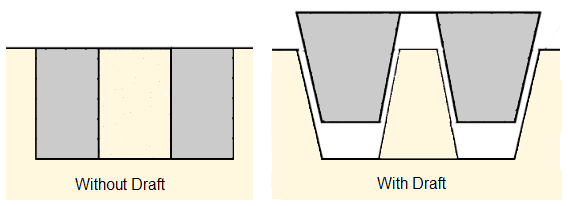Types of Pattern Allowance and Its Reason- Shrinkage, Draft, Finishing, Shake, Distortion, Mold wall movement
The difference in the dimension of pattern and final product of casting is known as the pattern allowance. Allowance compensates any dimensional variation during the casting process. Patterns are given the various types of allowance, the reason for these allowances are different. Some of the types of allowance are listed below
Factor affecting the allowance of Pattern
- The composition of alloys
- The complexity of pattern and component size.
- The mold material used
- Mold design
Shrinkage /contraction allowance
The metal casting process includes the transition of metal from one phase to another (liquid state to solid). Normally all metals shrink when it is cooling down. The shrinkage depends on the type of material and the metallurgical transformation during the solidification. Even though the pattern maker knows the rate of shrinkage of certain material, they are expected to try some trial before fixing shrinkage allowance for an intrinsic shape.There are three types of shrinkage in casting
Liquid shrinkage: Reduction of volume of metal when it transforms from liquid phase to solid state at solidus temperature.
Phase transformation shrinkage: Shrinkage of metal during phase transformation.
Solid shrinkage: The reduction in volume as the solid metal cooling down.
Liquid shrinkage and Phase transformation shrinkage are compensated by feeding molten metal from the riser till metal solidified.
🔗What is Shrink rule?
;🔗Why shrinkage allowance of outer surface is higher than inner surface?
Draft/ taper allowance
It is hard to remove casted object from pattern if it has vertical faces as shown in following fig. [image]
Vertical face causes a continuous contact or friction when object is removing from the pattern. The leading edge may break off during removal of the cast. In order to permit removal and reduce the defects, the vertical faces of the pattern are tapered in small angle known as draft angle. This provision is known as draft allowance. The inner surface pattern required more draft than the outer surface. The outer surface is given draft angle 1to 3 degrees while the inner part is given 5 to 8 degrees.
Draft allowance varies for hand moldings and machine moldings. Usually, the hand molding provided more draft than machine molding. In machine moldings, it further depends on the conditions of machine (New, alignment, etc.)
- The angle of Draft is such a way that it always provides an extra metal over the original casting
- The smaller vertical surface needs more draft angle than larger surface
Finishing/machining allowance
Finishing and dimensional accuracy obtained by a casting product are poor. The ferrous material would have scales on the skin when it solidifies. Moreover, in almost all cases, the fine details of the surface are eliminated from the pattern. To get dimensional accurate, clean, aesthetically pleasing product, a subsequent finishing operation such as grinding, turning is needed to be done on this casted object. During the finishing process, some metal is removed from the cast. To compensate this, some extra material should be provided to casting. The machining allowance ensures this additional metal in casting.The finishing allowance depends on the material, complexity of surface details, type of molding, dimension, surface finishing and accuracy required for the product. The volume of material provided by this allowance completely removed by a machining operation. In order to reduce the machining allowance and hence cost, it is better to place entire cast inside the drag flask such that reducing defect due to parting plane.
Shake allowance
Sometimes the pattern is rapped around the vertical surface of the sand mold to slightly enlarge the mold cavity so that it can easily remove from a sand mold. It causes an increase in cast dimensions parallel to the parting line. Since this highly depends on the foundry personal and practices involved, there is no sure way to quantify shake allowance. However, to reduce this enlargement of casting, a negative allowance is provided to the dimensions which are parallel to the parting line. One way to avoid shake allowance is that to increase the draft allowance.- Increase in of draft allowance reduces need the shake allowance
🔗Types of pattern material - Application, advantages and limitation
🔗Types of Patterns used for casting
🔗Color Codes Used In Pattern (Casting Process)




